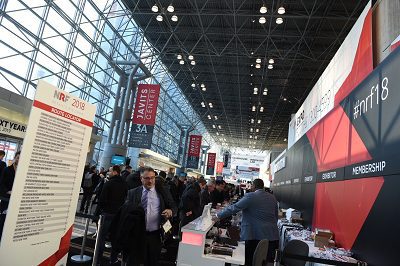The National Retail Federation Big Show 2018 is in the rear-view mirror now, but the insights that were shared will make their mark throughout the coming year. The good news is that, judging by the crowds and overall excitement at New York City’s Javits Center, the retail industry is definitely not in an apocalyptic — or even a post-apocalyptic — phase. In fact, a roundtable of economists pointed to strong holiday sales, high consumer confidence levels and the recent tax cuts as reasons for optimism in the coming year.
The Retail TouchPointseditorial team shares some of the major headlines from the show, which was held January 14-16, including:
• The CEO of Boxed would not rule out an acquisition by a brick-and-mortar retailer, perhaps Kroger;
• Case studies from eBay, Cosabella and 1-800-FLOWERS.com showcased the benefits and the limits of AI;
• China’s clout in e-Commerce will continue to grow rapidly, according to the Alibaba VP for North America;
• Grocers have lost market share: today food retailers provide only 35% of the nutrition consumed, with the remaining 65% supplied by out-of-home restaurants or meal kits; and
• Card-based contactless payments, already popular outside the U.S., will be the next advance in speeding up checkouts.
High Consumer Confidence, Tax Cuts Lead To A Promising 2018
NRF Chief Economist Jack Kleinhenz held a roundtable to discuss the economic outlook for shoppers in 2018. Gad Levanon, Chief Economist of The Conference Board, and Brian Nagel, Equity Research Analyst at Oppenheimer & Co., agreed that retail growth is likely to exceed the gains made in 2017, especially with consumer confidence hitting a 17-year-high in November.
In November and December 2017, retailers had their best holiday season since 2010, boosting sales during the crucial holiday months by 5.5%. According to NRF data, shoppers spent $691.9 billion over the period, greatly outspending initial NRF holiday growth forecasts that ranged from 3.6% to 4%.
Retailers pay one of the highest corporate tax rates in the U.S., in some cases as high as 38%, but the tax reform bill will reduce that to approximately 25%. Nagel said Costco could save as much as $400 million in 2018 as a result of the cuts, with The Home Depot set to save more than $1 billion.
Boxed CEO Responds To Acquisition Reports, Says Brick-And-Mortar Future Is ‘Definitely’ In Play
In a session titled The Direct-To-Consumer Uprising, Boxed CEO Chieh Huang faced questions about reports that the online wholesaler may agree to be acquired by Kroger for as much as $500 million. Huang noted that his personal dream always has been to take Boxed public, but he wouldn’t confirm or deny the reports.
“Retailers have always had interest in us,” Huang said. “I would say given our scale now and given the fact that everyone believes that pure play online is no longer just a toy, that a lot of these inbound interests from retailers with an accelerator strategy have become more tangible. Grocery online is no longer just a side show. It’s a battleground for not just the biggest retailers on earth, but the biggest companies.”
While Boxed’s online presence, technology rollouts, private brands and fulfillment centers would provide a boost to the Kroger brand, Huang said brick-and-mortar expansion “is definitely in our future” amid merchandising expansion. Huang also referenced Walmart’s shuttering of 63 Sam’s Club stores as a possible entrance point in the physical space.
“Even in the back of my mind, I’m thinking…some of those stores would be excellent for us,” Huang said. “Could we use that space as fulfillment centers and actually make a more Millennial-focused experience? Potentially.”
EBay, Cosabella And 1-800-FLOWERS.COM Showcase AI Capabilities
Retailers are beginning to share more about both the benefits and the limits of Artificial Intelligence (AI). Deborah Weinswig, Managing Director of Fung Global Retail and Technology, hosted a panel that highlighted case studies from eBay, Cosabella and 1-800-FLOWERS.COM.
Chris McCann, CEO of 1-800-FLOWERS.COM, pointed out that his company’s GWYN (Gifts When You Need) AI-powered gift concierge still needs a human touch in order to function correctly.
“We often say automation for automation’s sake would clearly deliver the wrong message,” McCann said. “To some degree, we take a human-nurtured augmented intelligence approach. How do you get that balance to make sure that the technology is making the right decision? It’s a learning process, and it’s what we’re going through with GWYN. We need to show that GWYN is understanding what to look for, what attributes need to be put into our product day-to-day based on what we’ve learned so far. This isn’t the world where we just give everything over to the computer. There’s always a place for people.”
Kris Miller, Chief Strategy Officer of eBay, indicated that the online giant seeks to take ownership of AI across the entire organization, deploying it at multiple points of the purchase process, from the consideration stage to the online browsing stage and the post-purchase stage. The retailer has acquired three companies since 2016 (SalesPredict, Expertmaker and Corrigon) to foster its data analytics, machine learning and image recognition capabilities.
Silvia Campello, President and COO of Cosabella, noted that email targeting has been the “most impressive change,” for the brand since implementing the Albert AI engine. After three months with Albert, Cosabella saw a 336% increase in return on ad spend (ROAS).
“For Black Friday, all the process flows that we were able to implement this year that speak to the different segments individually resulted in a 100% revenue growth,” Campello said. “It was dramatic for us and something we really didn’t expect to see, but we’re thankful.”
China’s Online Commerce Clout Will Continue To Grow
Data shared by Lee McCabe, VP and GM for Alibaba North America, put the enormous power of Chinese consumers — and the companies that serve them — in perspective:
• By 2019, more than one in four (26.7%) of all global online shoppers will be in China, but because they are far more active than other online consumers, they will account for 57% of global online sales;
• In 2010, China and the U.S. each had approximately 140 million online shoppers; by 2020, China is projected to have 891 million online shoppers, compared to 270 million in the U.S.;
• By 2025, Chinese consumers will represent 44% of global luxury sales;
• International brands are already in China: 75% of the world’s most valuable brands, as measured by Forbes, are on Tmall, the Alibaba B2C site; and
• 80% of all e-Commerce in China goes to one of Alibaba’s sites.
Alibaba has supercharged its growth by optimizing user data, leveraged across “a fully integrated media and retail ecosystem,” said McCabe. The company’s Real Person Identity ensures that each consumer has the same user ID and password across all of Alibaba’s many businesses and sites. “This means we get full dimension analysis of shopping habits, transactional detail, browsing, searching and media viewing,” he added.
Another measure of Alibaba’s growth is seen in its Singles Day results. When the one-day event kicked off in 2009, Alibaba recorded $7 million in sales during a 24-hour period. By 2017, that number had ballooned to $25.3 billion.
Research: Grocers Must Adapt To Changing Shopper Behaviors
“The grocery industry is in transformational turmoil,” said Greg Girard, Program Director of Merchandise Strategies for IDC Retail Insights as he kicked off a session alongside Graeme McVie, Chief Business Development Officer for Precima. The two experts presented recent research that included insights from 200 food retailers and 3,000 shoppers. Results emphasized that food retailers need to continue to adapt their omnichannel assortment practices to sustain a competitive advantage.
“There are issues around pricing, price deflation, European price leaders [Aldi, Lidl], the Amazon-Whole Foods acquisition, and new competitors like Blue Apron and FreshDirect,” said Girard. “[The research found that] food retailers only provide 35% of all the nutrition/calories/meals we all consume. The rest [65%] is out-of-home meals from restaurants and meal kits. Grocers have lost tremendous market share.”
Key takeaways from the research include:
- Shopper fragmentation is an issue. Today, 25% of shoppers shop at multiple stores to satisfy their grocery needs.
- Most shoppers want retailers to deliver the basics but they also want the differentiators. Consumers of all age groups are interested in personalized prices and promotions, as well as better in-store experiences.
- Shoppers value time spent in stores. More than 50% of respondents revealed they spend the most time in the fresh fruit and vegetable departments.
- Retailers need to carefully manage the generational shift from Boomers to Millennials. Older shoppers value a lot of options in “fresh categories,” while the younger generation prefers more options in home products and health and beauty care products.
EMV Has Reduced Counterfeit Card Fraud 65%
The U.S. payment ecosystem’s move to the EMV standard has helped reduce counterfeit card fraud by 65% to 70%, according to Visa CEO Alfred Kelly. “Close to two-thirds of all payment terminals are now EMV-enabled, and 470 million credit or debit cards in the U.S. have a chip in them,” he said during the session titled, The Future Of Commerce And Payments.
The next step — one that will address the additional time needed at checkout for dipping chip-enabled cards — will be a move to card-based contactless payment. “That means tapping versus swiping or dipping, and it can also apply to NFC-enabled smartphones and wearable devices,” Kelly explained. “The U.S. is way behind all the developed countries in this area. It’s very big in Canada and the UK. In Australia, 90% of transactions are contactless, compared to less than 1% in the U.S.”
The next wave of credit and debit card renewals is likely to include contactless payment capability, and “more than 90% of the terminals that are shipping are set up for contactless,” said Kelly. “Contactless payment will make checkouts quicker again, and it also will be easier for cashiers, since they won’t have to take the card from the customer” to process transactions.
With AI, Ethics Can’t Be An Afterthought
The future of AI depends on end users — both retailers and consumers — having a trustworthy experience, according to Francesca Rossi, AI Ethics Global Leader and Distinguished Research Staff Member for IBM Research AI. To build those levels of trust, data scientists and algorithm developers need to incorporate ethical structures into all phases of design, development and deployment.
“This isn’t something that can be done by the designers and developers themselves,” said Rossi, who participated in a panel discussion, titled: Retailing Ethics In The Age Of Artificial Intelligence. “It needs to be multi-disciplinary, including philosophers, economists, the people that will deploy the systems and those that will use them.”
In AI, ethical issues fall into two major categories. One involves the data being used: “Is the data being fed into the system clean and unbiased, so that we can avoid accidental or intentional discrimination?” said Anindya Ghose, Professor of Business at the NYC Stern School of Business. The other element concerns the sometimes “black box” nature of AI programs: “Can we explain why the algorithm acted in a certain way?” said Ghose. “Often we will know what we’ve created, but it’s difficult to explain why it behaved the way that it did.”
Solving these ethical issues is vital, according to the Venerable Tenzin Priyadarshi, Director of the Ethics Initiative at the MIT Media Lab. “We have to start thinking about AI and other systems as being interdependent,” he said. “AI is one of the systems that will influence human interactions, and the consumer aspect of society is just one area where it will do so.”
“It’s all about transparency, trustworthiness and basing systems on explainability,” said Rossi.
DAVIDsTEA Increases Revenue 30% With 1:1 Customer Engagement
Catherine LaPorte, Head of Marketing for DAVIDsTEA, revealed how the company, which was built on the idea of community in an effort to make tea accessible and fun, needed to personalize its interactions with customers. As David’s Tea turned its focus to digital marketing strategies, the company tapped AgilOne to personalize engagements with customers in meaningful ways.
“With a predictive model, we have the ability to foresee where our customers will move, so a customer can be a ‘discounter’ one week and a ‘mainstream’ customer the next,” said LaPorte. “The attributes and different levels of complexity around the customer are very large for us. We built our business from zero to 240 stores because of the store experience. Now, I have been tasked to double and triple our online business while not hurting our in-store efforts. The only way we can do that is knowing our customer and unlocking those one-to-one relationships across all the different touch points. That’s where AgilOne has been helpful.”
Since working with AgilOne, David’s Tea has experienced:
- A 30% increase in revenue from email (over 50% of the company’s transactions in stores come from customers who receive communication via email);
- A 20% increase in open rates; and
- An 8% increase in click through rates.
For additional coverage of the NRF Big Show, visit the Retail TouchPoints #NRF2018 hub.













